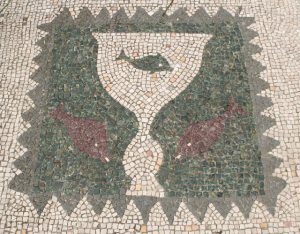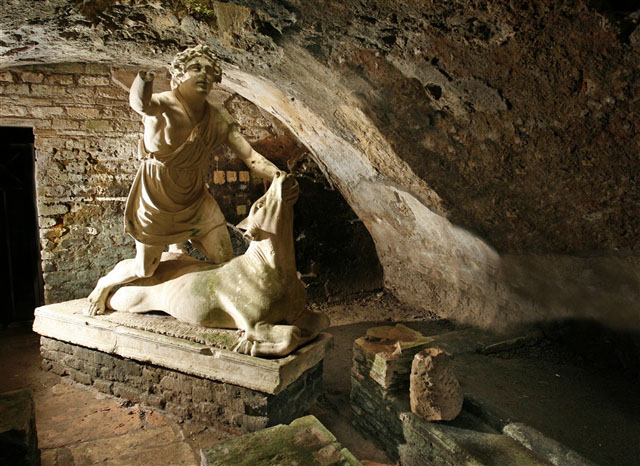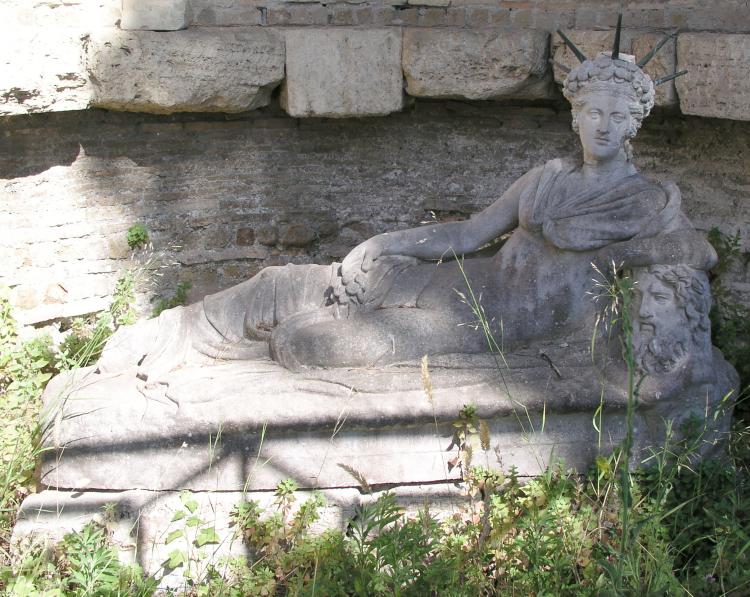Secret Alias wrote: ↑Thu Apr 08, 2021 4:39 pm
For Gaius was known in antiquity as ‘the bishop of the nations’ or if you will the Pauline episcopal counterpart to the Petrine bishop of Rome.
You are no doubt familiar with the context, but I needed a refresher.
http://www.tertullian.org/fathers/photi ... eca.htm#48
I find a marginal note to the effect that the work is not by Josephus, but by one Gaius,3 a presbyter of Rome, also the author of The Labyrinth,4 and of a dialogue against Proclus, the champion of the Montanists.5 The latter, which had no ascription, is attributed by some to Josephus, by others to Justin Martyr, and The Labyrinth to Origen. But there is no doubt that the work is by Gaius, the author of The Labyrinth, who at the end of this treatise has left it on record that he was the author of The Nature of the Universe. But it is not quite clear to me, whether this is the same or a different work. This Gaius is said to have been a presbyter of the Church at Rome, during the episcopate of Victor6 and Zephyrinus,7 and to have been ordained bishop of the gentiles. He wrote another special work against the heresy of Artemon,8 and also composed a weighty treatise against Proclus, the supporter of Montanus. In this he reckons only thirteen epistles of St. Paul, and does not include the Epistle to the Hebrews.
http://www.textexcavation.com/gaiusrome.html
The Dialogue with Proclus, the Labyrinth, Against the Heresy of Artemon, and On the Essence of the Universe were all written by a certain Gaius, a Roman presbyter, who was ordained in the time of Victor and Zephyrinus, and was bishop of the nations. (All this according to a marginal note in the Dialogue that Photius read, though his copy elsewhere attributed itself to Josephus.) Photius, Bibliotheca 48.2
The Labyrinth, far from having been authored by Gaius, is actually the tenth book of the Refutation of All Heresies by Hippolytus, according to Hill, page 197. Likewise, On the Essence of the Universe is regarded as Hippolytan (ibidem). Against the Heresy of Artemon is apparently (according to Lightfoot on page 378 of The Apostolic Fathers, part 1, volume 2) a descriptive name for another Hippolytan work, the Little Labyrinth. Only the Dialogue with Proclus is known to be from the pen of Gaius. Lightfoot hypothesized that these four books were at one time bound together, and only the last identified its author internally; hence the attribution of all four to Gaius (see Hill, page 197, especially note 79).
J. B. Lightfoot argues persuasively that there was no separate person of Gaius; that this was just the name of the interlocutor in the text that Hippolytus created of a disputation with Proclus.
http://www.earlychristianwritings.com/l ... ippo4.html
Having thus given the facts which bear upon the decision, I will state my hypothesis. Unless I am mistaken, it explains all the phenomena better thatn they have hitherto been explained; and, if so, it may fairly claim a hearing.
Gaius is simply an interlocuter in a dialogue against the Montanists written by Hippolytus. By this person, who takes the orthodox side in the discussion, Hippolytus may have intended himself, or he may have invented an imaginary character for dramatic purposes. In other words, such a dialogue may really have taken place, or the narrative may be fictitious from beginning to end. In the former case, we may suppose that Gaius was his own praenomen; for then he would naturally so style himself in the dialogue, just as Cicero appears under the name of Marcus in his own writings. Not being a slave and being in some sense a Roman, Hippolytus must almost necessarily have had two names, if not more; just as his Alexandrian contemporary Q. Septimius Florens Tertullianus. Such a combination as Gaius Hippolytus is natural in itself, and indeed occurs in an extant inscription found at Placentia; Q. POBLICIO L.L.C. HIPPOLYTUS2. On the latter supposition (that Gaius is an imaginary person), we may appeal to the legal formula 'Ubi tu Gaius, ego Gaia,' as suggesting that Hippolytus might avail himself of the name which corresponds to the anonymous N. or M. of our own formularies1. Of the former kind of dialogue, where the author himself is the orthodox disputant, the work of Justin against Trypho may be taken as a type: of the latter, where a fictitious person maintains the right cause, the dispute between Jason and Papiscus by Ariston of Pella will serve as an example2.
I suppose then that the copies of the Dialogue in general circulation were anonymous. The title may have run Διαλογος Γαιου και Προκλου (or προς Προκλον) η κατα Μοντανιστων. A writer, into whose hands this Dialogue fell, would naturally infer, as Eusebius inferred, (and the analogy of Justin's work would favour the inference), that Gaius was the actual author of the book. The few particulars which Eusebius gives respecting the life of Gaius were doubtless drawn form the Dialogue itself. Thoes which are added by Photius came from the other writings attributed to Gaius, from the Cause of the Universe or the Labyrinth, or perhaps from the Refutation itself. The critics, whom he quotes and to whom he is indebted for these particulars, had observed the cross references from one work to another and correctly inferred therefrom the identity of authorship. Among these cross references was one which connected the authorship of the Dialogue of Gaius and Proclus with the other works, just as these are connected among themselves and proved to belong to the same author. Hence Gaius assumed to be the author of the Dialogue was credited with the other works also.
This is the explanation of the fact that all the particulars, which are predicated of Gaius, are predicated or predicable of Hippolytus also. They both flourish during the same pontificates; they are both styled 'presbyters,' and both live in Rome; they both receive only thirteen Epistles as written by St Paul, excluding the Epislte to the Hebrews; they both are men of great learning, though the Roman Church for some generations before and after this time was singularly devoid of literary eminence. And lastly, we have here an explanation of the otherwise not very intelligible statement, that Gaius was appointed 'bishop of the Gentiles' (AR. 32. a); for Hippolytus in the Refutation speaks of himself as holding the episcopal office (AR. 1), and addresses the Gentiles more than once as though they were his special charge1. If the designation 'bishop of the Gentiles' is not strictly correct, it was at least a very easy inference from his language in this work; and probably he expressed himself similarly elsewhere, when the occasion demanded, as for instance in the treatise on the Universe addressed to the Greeks.
To this identification of Gaius and Hippolytus another ancient notice also points. The extant manuscripts of the Martyrdom of Polycarp profess to be derived ultimately from a copy which was 'transcribed from the writings (or manuscripts or lectures) of Irenaeus the disciple of Polycarp by Gaius who also was intimate with Irenaeus2.' Now I shall not stop to enquire whether this postscript to the account of Polycarp's martyrdom contains authentic matter or not; but in any case it would seem that the transcriber here intended was none other than our Gaius, the Roman presbyter; for he is the only notable personage of the name and age, whose attestation would be of value to accredit the genuineness of the narrative. If so, it is remarkable that he is represented as a disciple of Irenaeus. For Hippolytus also attended the lectures of this father, and was much indebted to them for the materials of his earlier Compendium against Heresies. In his later Refutation also he twice mentions Irenaeus as 'the blessed elder,' and in the second of the two passages avows his great obligations to him (Ref. Haer. VI. 42, 45). May we suppose that Gaius in the Dialogue with Proclus expresses himself similarly with respect to this father?
There are a couple references in Epiphanius to the idea that some cities had two bishops:
Epiphanius, Panarion 68.7.3
Alexandria has never had two bishops, like the other cities
Epiphanius, Panarion 27.6
For the bishops at Rome
were, fi rst, Peter and Paul, the apostles themselves and also bishops—then
Linus, then Cletus, then Clement, a contemporary of Peter and Paul whom
Paul mentions in the Epistle to the Romans. And no one need wonder why
others before him succeeded the apostles in the episcopate, even though
he was contemporary with Peter and Paul—for he too is the apostles’ contemporary. (4) I am not quite clear as to whether he received the episcopal
appointment from Peter while they were still alive, and he declined and
would not exercise the offi ce—for in one of his Epistles he says, giving
this counsel to someone, “I withdraw, I depart, let the people of God be
tranquil,”29 (I have found this in certain historical works)—or whether he
was appointed by the bishop Cletus after the apostles’ death.
6,5 But even so, others could have been made bishop while the apostles,
I mean Peter and Paul, were still alive, since they often journeyed abroad
for the proclamation of Christ, but Rome could not be without a bishop.
(6) Paul even reached Spain, and Peter often visited Pontus and Bithynia.
But after Clement had been appointed and declined, if this is what happened—I suspect this but cannot say it for certain—he could have been
compelled to hold the episcopate in his turn, after the deaths of Linus and
Cletus who were bishops for twelve years each after the death of Saints
Peter and Paul in the twelfth year of Nero.)
6,7 In any case, the succession of the bishops at Rome runs in this order:
Peter and Paul, Linus and Cletus, Clement, Evaristus, Alexander, Xystus,
Telesphorus, Hyginus, Pius, and Anicetus, whom I mentioned above, on
the list.30 And no one need be surprised at my listing each of the items so
exactly; precise information is always given in this way. (8) In Anicetus’ time
then, as I said, the Marcellina I have spoken of appeared at Rome spewing
forth the corruption of Carpocrates’ teaching, and corrupted and destroyed
many there. And that made a beginning of the so-called Gnostics.
Some have tried to solve the problem of the inconsistent bishop lists by suggesting that Clement followed Paul (as he is sometimes first after the apostles in tradition), while both Linus and Cletus succeeded Peter (as "bishop of the Jews").
https://books.google.com/books?id=N6nhA ... e=bookclip
CLEMENT is generally denominated the firsť Bishop of Rome though he is also by numerous authors stated to be the third Linas being the first and CLETUS or ANACLETUS the second. The most esteemed authorities agree that he was Bishop from the year 64 to 81 while others affirm he did not receive that distinguished authority until 91 or 92. CLEMENT is alleged by some to have succeeded St Paul as Bishop of the Gentiles and LINAS and after the latter CLETUS to have succeeded St PETER as Bishop of the Jews and that when the distinction between Jew and Gentile was discontinued CLEMENT SUCceeded Cletus as sole Bishop thence accounting for the difference in the historical accounts as to his numerical rank as Bishop for it is evident he would be the first Bishop at Rome of the Gentiles if the Apostle Paul be excluded or the third Bishop at Rome if both the Apostles Paul and Peter be omitted and the successors of the latter LINAS and CLETUS be alone admitted while he would be the first Bishop of Rome including both Gentiles and Jews combined
The Catholic Encyclopedia characterizes Hippolytus as an "antipope" (a pretender as bishop of Rome):
In the reign of Pope Zephyrinus (198-217) he came into conflict with that pontiff and with the majority of the Church of Rome, primarily on account of the christological opinions which for some time had been causing controversies in Rome. Hippolytus had combated the heresy of Theodotion and the Alogi; in like fashion he opposed the false doctrines of Noetus, of Epigonus, of Cleomenes, and of Sabellius, who emphasized the unity of God too one-sidedly (Monarchians) and saw in the concepts of the Father and the Son merely manifestations (modi) of the Divine Nature (Modalism, Sabellianism). Hippolytus, on the contrary, stood uncompromisingly for a real difference between the Son (Logos) and the Father, but so as to represent the Former as a Divine Person almost completely separate from God (Ditheism) and at the same time altogether subordinate to the Father (Subordinationism). As the heresy in the doctrine of the Modalists was not at first clearly apparent, Pope Zephyrinus declined to give a decision. For this Hippolytus gravely censured him, representing him as an incompetent man, unworthy to rule the Church of Rome and as a tool in the hands of the ambitious and intriguing deacon Callistus, whose early life is maliciously depicted (Philosophumena, IX, xi-xii). Consequently when Callistus was elected pope (217-218) on the death of Zephyrinus, Hippolytus immediately left the communion of the Roman Church and had himself elected antipope by his small band of followers. These he calls the Catholic Church and himself successor to the Apostles, terming the great majority of Roman Christians the School of Callistus. He accuses Callistus of having fallen first into the heresy of Theodotus, then into that of Sabellius; also of having through avarice degraded ecclesiastical, and especially the penitential, discipline to a disgraceful laxity. These reproaches were altogether unjustified. Hippolytus himself advocated an excessive rigorism. He continued in opposition as antipope throughout the reigns of the two immediate successors of Callistus, Urban (222 or 223 to 230) and Pontius (230-35), and during this period, probably during the pontificate of Pontianus, he wrote the "Philosophumena".
Just some notes, so far.




